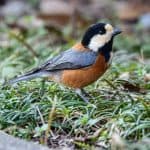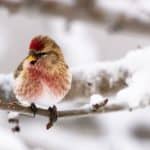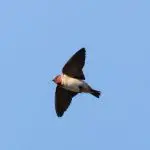Common Name: ʻAkikiki
Scientific Name: (Oreomystis bairdi)| Size | Diet | Range in Hawaii | Status in Hawaii |
|---|---|---|---|
| 4.5 in. - 5.5 in. | insects and spiders | Kaua’i | Critically Endangered |
The ʻAkikiki (Oreomystis bairdi), also known as the Kauaʻi Creeper, is a small and charming bird species that is native to the island of Kauaʻi in Hawaii. With its distinctive black and yellow plumage and unique foraging behavior, this bird is a beloved sight in its natural habitat.
However, the species is also listed as endangered due to habitat loss and predation, making it a rare and precious sight for birdwatchers. In this article, we’ll explore the fascinating world of the ʻAkikiki, its unique adaptations, and its behavior in the wild.
ʻAkikiki
Appearance
The ʻAkikiki, is a small bird native to the island of Kauai in Hawaii. This critically endangered species displays a unique and charming appearance.
Measuring approximately 4.5 to 5.5 inches (11 to 14 centimeters) in length, the ʻAkikiki is one of the smallest bird species found in Hawaii. It has a compact body with a short, straight bill and rounded wings. Despite its small size, this bird showcases a remarkable blend of colors and patterns.
The plumage of both male and female ʻAkikiki is similar, featuring an attractive combination of olive-green and yellow feathers on the upper parts. The upper parts’ olive-green hue provides excellent camouflage within the native koa and ʻōhiʻa forests it inhabits. The underparts are lighter in color, often tinged with a subtle yellow shade.
In addition to its colorful plumage, the ʻAkikiki has distinctive features such as a round head, dark eyes, and a short tail. Its small size and agile nature allow it to maneuver swiftly among the upper canopies of trees while foraging for insects and spiders.
Diet
The diet of the ʻAkikiki primarily consists of insects and spiders. As a small bird endemic to the island of Kauai in Hawaii, the ʻAkikiki has developed specific foraging behaviors and feeding preferences.
This critically endangered species is known for its agile and acrobatic feeding style. It actively searches for prey by hopping and flitting among the upper canopies of native koa and ʻōhiʻa forests, utilizing its small size and maneuverability to its advantage. The ʻAkikiki often hangs upside down from branches and foliage, meticulously searching for insects and spiders hiding in crevices or among leaves.
In its quest for food, the ʻAkikiki has a particular affinity for small arthropods. It feeds on a variety of invertebrates, including beetles, caterpillars, spiders, and other small insects. The bird’s slender bill allows it to probe into tight spaces and extract its prey with precision.
Nesting
The ʻAkikiki constructs its nest primarily using plant materials such as twigs, leaves, and moss. The nest is typically cup-shaped and situated in the upper branches of native trees, particularly koa and ʻōhiʻa. The choice of location helps provide protection from potential predators and offers a suitable environment for nesting.
Breeding season for the ʻAkikiki generally occurs during the spring and early summer months. Monogamous pairs form, and both male and female birds participate in nest building. They work together to weave and interlace the materials, creating a sturdy and well-insulated structure for their eggs and eventual offspring.
The female ʻAkikiki typically lays one to two eggs, which are small and white with light speckles. The incubation period lasts for approximately 14 to 15 days, during which both parents take turns in tending to the eggs and maintaining the nest. Once the eggs hatch, both parents continue to share the responsibilities of feeding and caring for the chicks.
Behavior
The ʻAkikiki is highly active and constantly on the move, utilizing its small size and maneuverability to navigate the upper canopies of native koa and ʻōhiʻa forests. It is known for its acrobatic feeding behavior, often hanging upside down from branches and foliage while searching for insects and spiders. This unique foraging technique allows it to access hidden prey in crevices and among leaves.
The ʻAkikiki is primarily a social species and is often observed foraging in small groups or mixed flocks with other native Hawaiian birds. These social interactions may provide benefits such as increased foraging efficiency and improved predator detection.
During the breeding season, the ʻAkikiki forms monogamous pairs. Both male and female birds participate in nest building, incubating the eggs, and caring for the offspring. The cooperative nature of their breeding behavior helps ensure the successful raising of young.
Habitat
The ʻAkikiki inhabits the upper canopies of the island’s native koa (Acacia koa) and ʻōhiʻa (Metrosideros polymorpha) forests. These forests provide crucial resources and microhabitats that support the bird’s survival and breeding. The ʻAkikiki relies on the dense vegetation and diverse plant life found in these forests for foraging, nesting, and protection from predators.
The native forests of Kauai where the ʻAkikiki resides are characterized by a layered structure, with tall canopy trees forming the uppermost layer, understory vegetation below, and a dense understory of ferns, shrubs, and other plants. The ʻAkikiki is most commonly observed in the mid to upper canopy, where it actively forages for insects and spiders.
Range
The ‘Akikiki, a bird species native to the Hawaiian Islands, is primarily found in the high elevation forests of Kaua’i. Historically, it was also known to inhabit the slopes of other islands in the archipelago, including O’ahu, Moloka’i, Lana’i, and Maui. However, over time, the ‘Akikiki’s range has significantly contracted, and its population has declined.
Currently, the ‘Akikiki is mainly restricted to the interior Alaka’i Plateau within Koke’e State Park on Kaua’i. Surveys conducted in recent years have found small numbers of these birds in the high-elevation areas of the plateau. The remaining population is estimated to be around a few hundred individuals, making it a critically endangered species.
Conservation Status
The ‘Akikiki is currently listed as a critically endangered species. The population of ‘Akikiki has experienced significant declines over the years, primarily due to habitat loss, predation, and potentially avian diseases. These factors have resulted in a severe reduction in their numbers and a contraction of their range.
Interesting Facts
1. Distinctive plumage
The bird has a unique appearance with olive-green plumage on its upperparts and a yellowish-white belly. It also features a distinct black mask around its eyes, giving it a striking and recognizable appearance.
2. Vocal communication
‘Akikiki birds use a variety of vocalizations to communicate with each other. These vocalizations include soft chattering sounds, trills, and short, repetitive calls. These calls play a crucial role in maintaining social bonds and territorial defense.
3. Vulnerability to mosquito-borne diseases
Like many other Hawaiian honeycreepers, the ‘Akikiki is vulnerable to avian diseases carried by introduced mosquitoes, such as avian malaria. These diseases can be detrimental to their health and contribute to population declines.
4. Insectivorous diet
The primary diet of the ‘Akikiki consists of insects, spiders, and other arthropods. They actively forage through tree bark, moss, and foliage, using their bill to probe and extract small invertebrates.




